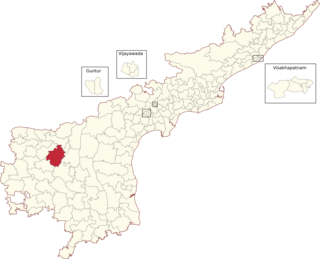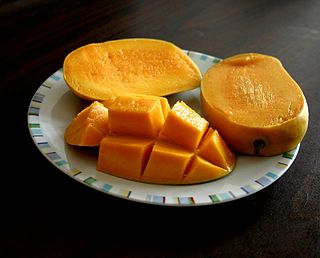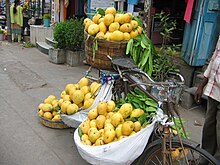
A mango is an edible stone fruit produced by the tropical tree Mangifera indica. It originated from the region between northwestern Myanmar, Bangladesh, and northeastern India. M. indica has been cultivated in South and Southeast Asia since ancient times resulting in two types of modern mango cultivars: the "Indian type" and the "Southeast Asian type". Other species in the genus Mangifera also produce edible fruits that are also called "mangoes", the majority of which are found in the Malesian ecoregion.

The tamarillo is a tree or shrub in the flowering plant family Solanaceae. It bears the tamarillo, an egg-shaped edible fruit. It is also known as the tree tomato, tomate de árbol, tomate andino, tomate serrano, blood fruit, poor man's tomato, tomate de yuca, tomate de españa, sachatomate, berenjena, chilto and tamamoro in South America, tyamtar, rambheda or rukh tamatar in Nepal, and terong Belanda in Indonesia. It is popular globally, especially in Peru, Colombia, New Zealand, Ecuador, Nepal, Rwanda, Burundi, Australia, and Bhutan.
Banaganapalli is a town in the state of Andhra Pradesh, India. It lies in Nandyal district, 38 km west of the city of Nandyal. Banaganapalli is famous for its mangoes and has a cultivar, Banaganapalli, named after it. Between 1790 and 1948, Banaganapalli was the capital of the princely state of the same name, Banganapalle State.
Panyam or Panem is a Town and Mandal Headquarter in Panyam Mandal, Nandyal district, Andhra Pradesh State. Panyam is a main town for the Panyam mandal.

Pootharekulu (plural) or poothareku (singular) is a popular Indian sweet from the Andhra Pradesh state of south India. The sweet is wrapped in a wafer-thin rice starch layer resembling paper and is stuffed with sugar, dry fruits and nuts. The sweet is popular for festivals, religious occasions and weddings in the Telugu states.

Kakinada Kaja is a traditional sweet pastry from Kakinada in Andhra Pradesh, India, known for its unique taste and preparation. It comes in two main varieties: the hollow, cylindrical Gottam Kaja and the layered Madatha Kaja, each offering distinct textures and flavours. The dessert holds significant cultural importance in Andhra Pradesh, with efforts underway to obtain a Geographical Indication (GI) tag to preserve its legacy. Along with the related Tapeswaram Kaja, it remains a beloved delicacy throughout the Telugu states.
Guntur Sannam or Capsicum annuum var. longum, is a variety of chili pepper that grows in the districts of Guntur, Prakasam, Warangal (Telangana), and Khammam in India. It is registered as one of the geographical indications of Andhra Pradesh.

Malgova' or Malgoa is an important mango cultivar mainly grown in Tamilnadu, Kerala and Karnataka and also in other parts of South India. It is a large round fruit, it has a small hard seed inside and is very juicy and fragrant. It is generally considered to be one of the best mangoes. Its production area is centred on the districts of Salem, Dharmapuri and Krishnagiri in Tamil Nadu, Gujarat, as well as neighbouring parts of Andhra Pradesh and Karnataka.

Banaganapalle Assembly constituency is a constituency in Nandyal district of Andhra Pradesh that elects representatives to the Andhra Pradesh Legislative Assembly in India. It is one of the seven assembly segments of Nandyal Lok Sabha constituency.
The Lakshmanbhog is a mango with very sweet taste, which is grown and harvested in the Indian state of West Bengal. Since 2008, the term Malda Laxman Bhog Mango is a registered geographical indication referring to the product—the Laxmanbhog mango—produced within Malda district. Apart from West Bengal, this mango is cultivated in Bihar and the neighboring country of Bangladesh. Mangoes are almost fibreless and agreeable in flavor; attractive orange yellow in color and very sweet in taste.

The Totapuri mango, or Ginimoothi, is a cultivar that is widely grown in south India and is partially cultivated in Sri Lanka. It also goes by the names Bangalore, Collector, Kallamai, Kili Mooku, Gilli, Mukku, "Ottu", and Sandersha. In Bengaluru it is referred to as Ginimoothi Maavina Kayi, while most of the rest of India calls it Totapuri or Bangalora. It literally translates to parrot face. Totapuri mango skin lacks the usual bitter taste of most mango skins or has a very slight bitterness and is consumed with the flesh traditionally.

The 'Gir Kesar' mango, also called Kesar, is a mango cultivar grown in the foothills of Girnar in Gujarat, western India. The mango is known for its bright orange colored pulp and was given the geographical indication status in 2011. The biggest market of Gir Kesar is in Talala Gir known as a Mango Market Yard.

Nagarkurnool district is a district in the southern region of the Indian state of Telangana. The town of Nagarkurnool is the district headquarters. It was part of the Mahbubnagar district prior to re-organisation of districts in the state. The district shares boundaries with Nalgonda, Rangareddy, Mahabubnagar, Wanaparthy districts and with the state boundary of Andhra Pradesh with Nandyal, Palnadu and Prakasam Districts.
Katasani Rami Reddy is an Indian politician from Andhra Pradesh. He is an MLA from Banaganpalle Assembly Constituency in Kurnool District. He won the 2019 Andhra Pradesh Legislative Assembly Election representing the YSR Congress Party. He has been nominated again to contest the Banaganpalle seat in the 2024 Andhra Pradesh Legislative Assembly election but he lost the election.
The 'Mankurad' mango, is a mango cultivar primarily grown in the coastal state of Goa, India. It is also cultivated in Vengurla and Malvan talukas of Maharashtra along within Uttara Kannada district of Karnataka. Malcorado, Mancurad, Mankur, Kurad, Corado are variations of the same name. Mankurad varieties include the Cardozo Mancurad, Costa Mancurad, Gawas Mancurad, and Amaral Mancurad.
The 'Malihabadi Dusseheri' mango, is a mango cultivar primarily grown in the town of Malihabad, Lucknow district of Uttar Pradesh, India. The Malihabadi Dusseheri mangoes are unique from the Dussehri variety grown elsewhere in India.
The 'Marathwada Kesar mango', is a mango cultivar primarily grown in Marathwada region of Maharashtra, India. Districts where they are primarily grown are Chhatrapati Sambhaji Nagar, Jalna, Beed and Latur.
The 'Rewa Sunderja' mango, is a mango cultivar primarily grown in Govindgarh of Rewa district, Madhya Pradesh, India.

Khirsapat mango is a variety of mango. It starts ripening from the beginning of summer. The fruits are drupes, and are medium-sized and round in shape. They are approximately 8 cm long, 7 cm wide, and weigh about 264 grams. The stalk of the Khirsapat mango is quite thick and firm. The skin is smooth, and when ripe, the upper part turns yellow. The middle to lower part of the mango remains light green. The edible portion is 67.2%. The flesh is fiberless and yellowish. The fruit is aromatic, juicy, and sweet.

The Edayur chilli is a variety of chilli mainly grown in the Indian state of Kerala. The Edayur chilli is a local cultivar primarily grown in specific regions of Kerala's Malappuram district. Specifically, it is cultivated in the panchayaths of Edayur, Athavanad, Marakkara, Irimbiliyam, Kalpakanchery, and Valanchery within the Valanchery block, as well as Moorkanad and Kuruva panchayaths within the Angadippuram block.













